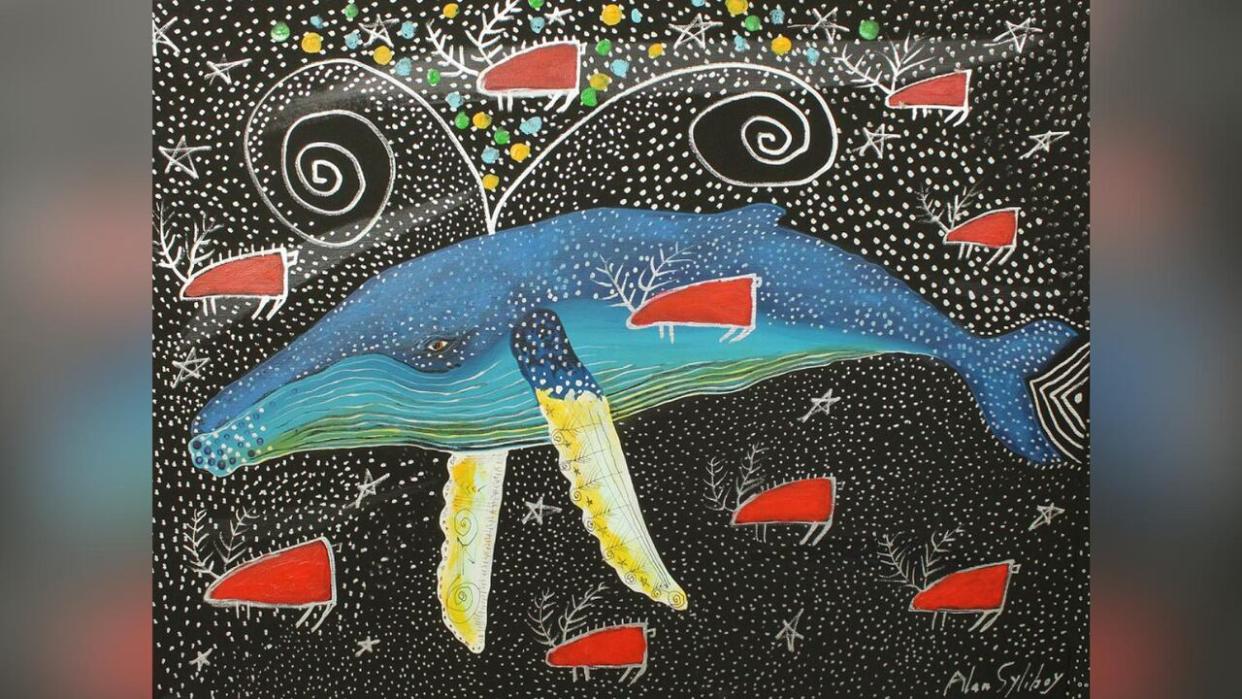This Mi'kmaw artwork will be on the moon forever

A piece of Mi'kmaw artwork now lives on the moon.
Alan Syliboy's Humpback Swimming in the Milky Way was sent to the celestial body on the SpaceX Falcon 9's lunar lander on Feb. 15. It landed on Feb. 22, where it will stay for the rest of time.
It's part of a global project created by a Toronto poet, archivist and physicist to make the moon a keeper of Earth's art.
Syliboy is one of 35,000 artists from around the world to send artwork into space.
"When you look at the moon your whole life, you never think that you're going to have something on that moon, on the moon — that never ever, ever occurs to you," Syliboy told CBC Radio's Mainstreet Halifax.
"But now, I have to look at it differently and something's changed … because there's a little bit of what I do preserved on the moon."
Project designed to inspire
The project's founder, Samuel Peralta, told Mainstreet the idea for the Lunar Codex came just before the COVID-19 pandemic when he was in a "bit of a funk."
And then the lockdowns hit and "artists were disenfranchised because galleries were closed, music halls were closed, theatres were closed."
But he had recently learned that private companies could send payloads of materials to the moon using NASA's outsourced lunar landers.
The Lunar Codex project describes itself as a "message-in-a-bottle to the future" that uses digital and analog technology to preserve art, books and music in a time capsules to be left on the moon.
"I decided to send up one of my poems in one of their payloads, and it's just a small sliver of a thing. But then I thought: what if I shared that payload space with other artists?" he said.

Samuel Peralta is the creator of the Lunar Codex and its payload co-ordinator. (Antosia Fiedur)
"Would they suddenly feel inspired and be moved to continue working, even though they were surrounded by all the depression that the lockdowns engendered?"
The answer was yes. And the project grew from there, he said.
How it works
Peralta said some of the art being sent is digital, while others, including Syliboy's painting, are analog.
He said the analog pieces are miniaturized using semiconductor technology and then etched onto dime-sized discs.
"If you look at it under a microscope, you will actually very clearly see Alan's work," he said.
"It won't exactly look like his work now, because what we do is we split it into three channels — the red, the green and blue — and when you combine them together, they form the full colour image."
He said the discs are then added to his Lunar Codex payload, which is then put into the nose cone of a lunar lander. That nose cone is then ejected from the lunar lander onto the moon.
Peralta said the project has changed the way artists view the moon.
"The moon has always been an object of inspiration. But now when an artist looks at it, whose work is on it, the moon is transformed. It becomes a deeper representation of how they feel because part of their soul is on it right now."
Selection of Syliboy's painting
Peralta said he discovered Syliboy's painting at an art gallery in Toronto. He and his wife mulled buying the piece, but when they came back to the gallery — it was gone.
So they decided to immortalize it by putting it on the Lunar Codex.
"That way it could achieve some immortality because those discs that are being sent up, they essentially last a million years. They last forever. They will outlast essentially the lifetime of the artist and render a kind of immortality."
Syliboy said when he started his career, he was inspired by petroglyphs — rock carvings made by people of the past, left behind as messages. He said this is a similar concept.

Mi'kmaw artist Alan Syliboy likens his art being sent to the moon to petroglyphs that were left behind as messages. (Submitted by Alan Syliboy)
"If you think about this, it is almost like a petroglyph. It's being discovered by someone else," he said.
"The petroglyphs were left there for me to discover and now ... [this painting is] in another place to be discovered, possibly, by some other entity."
A copy of the song, Ko'jua, performed by Morgan Toney and Alan Syliboy and the Thundermakers, was also sent to the moon.
MORE TOP STORIES

